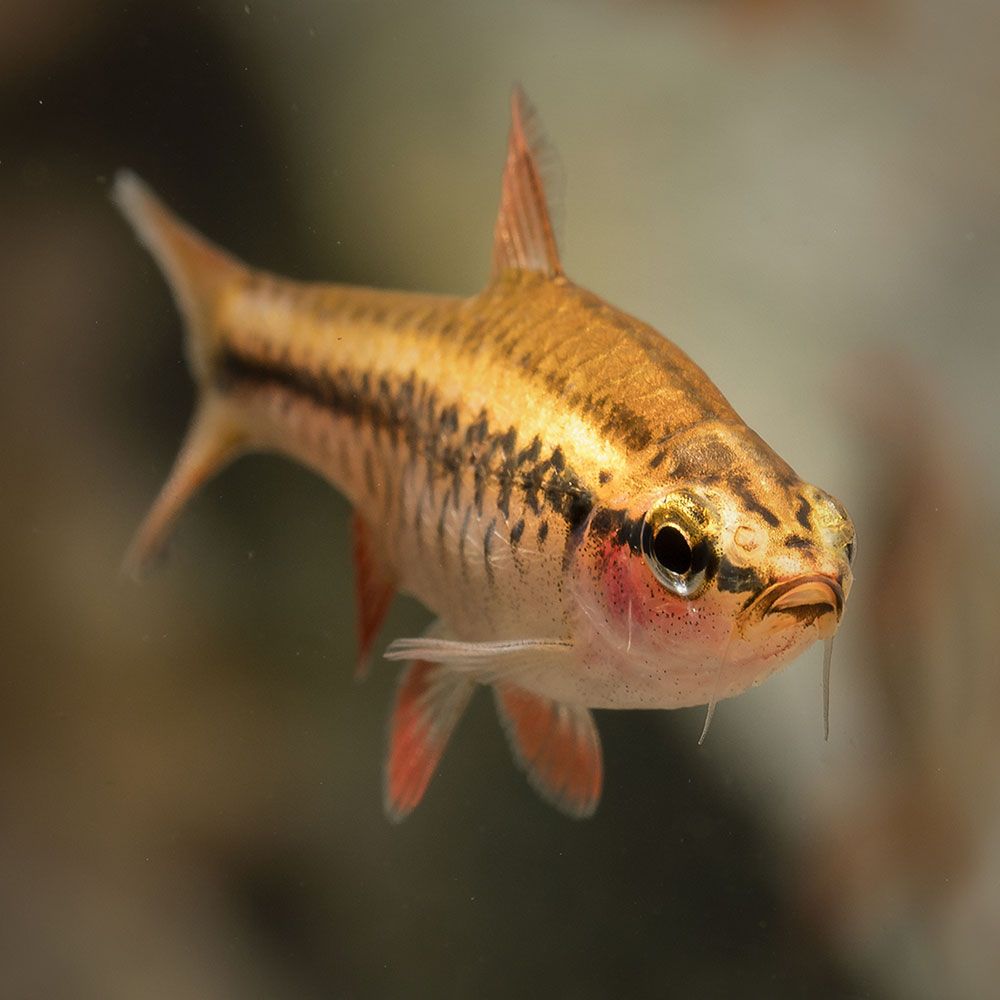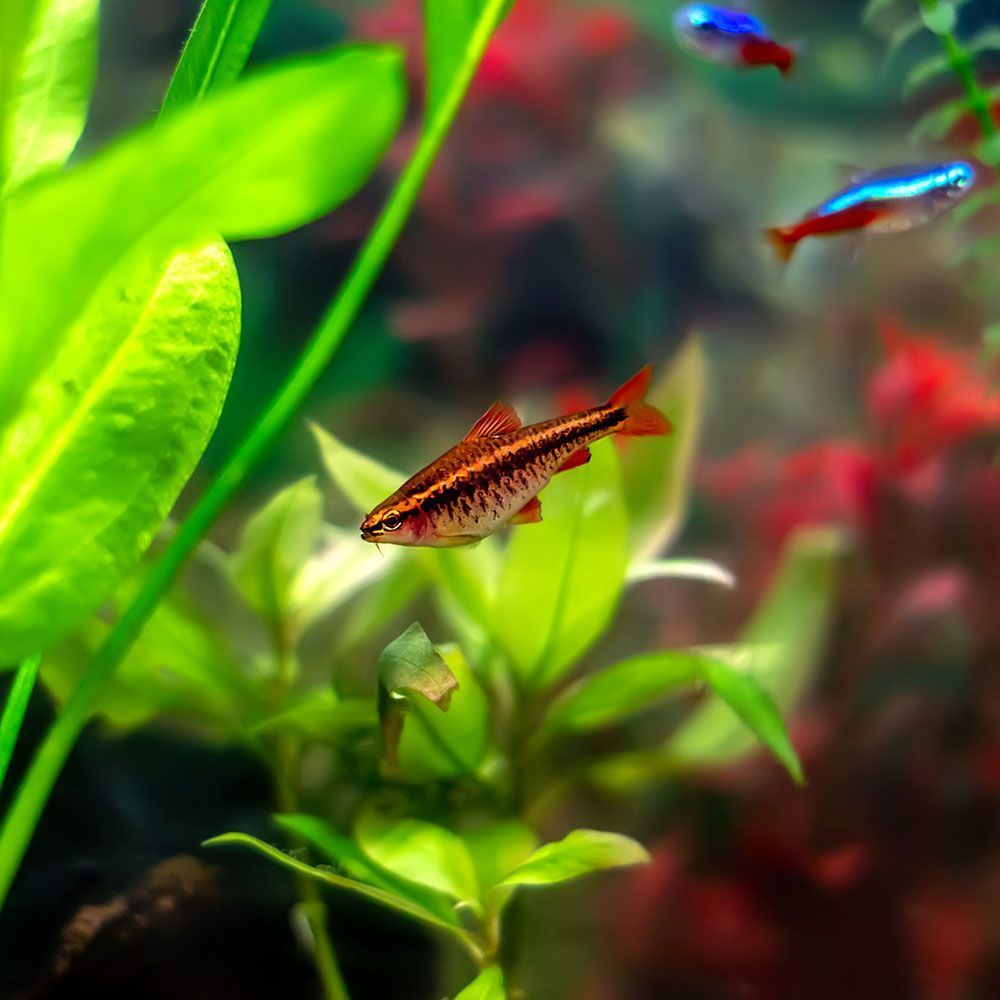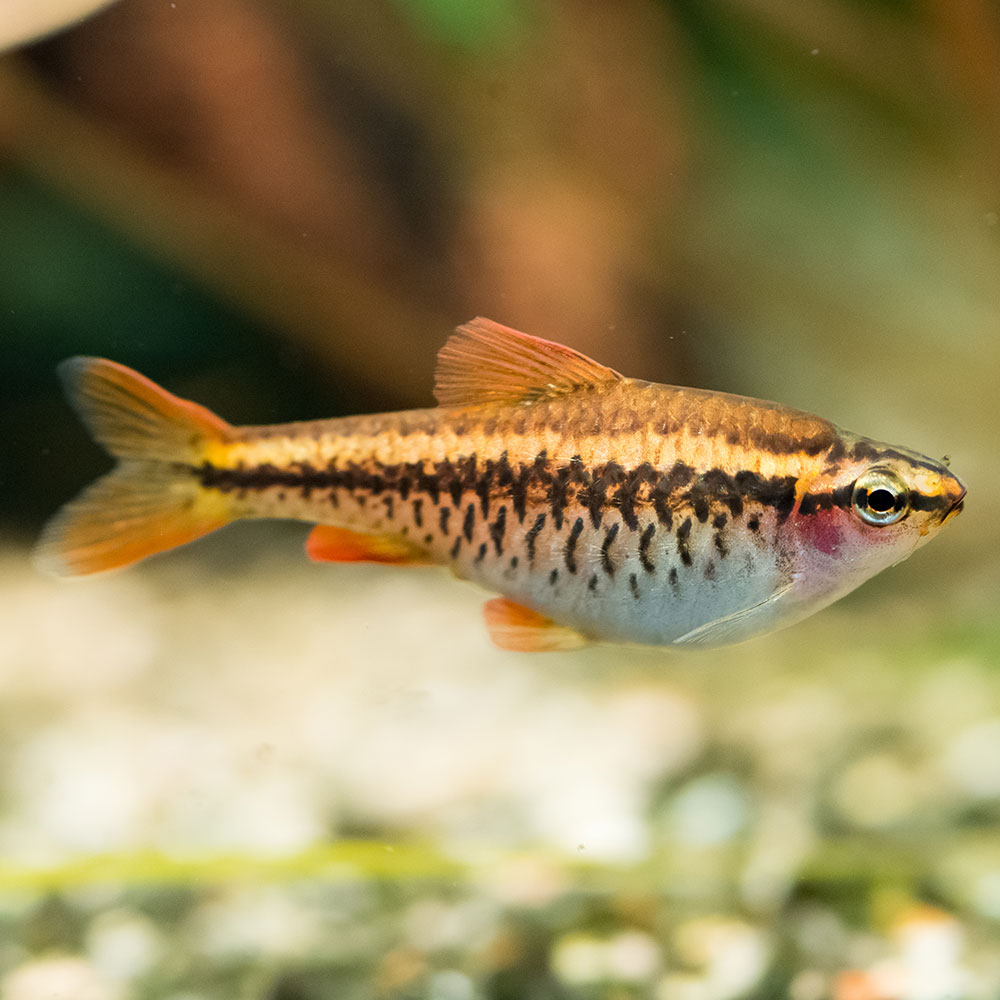The meek barb never makes any fuss while eating, which makes every mealtime a wonderful experience!
So, if this little being has caught your attention, keep reading to find out the best way to raise them.
What is a Cherry Barb?
The cherry barb is a peaceful freshwater fish that is great for beginners with community tanks. The vibrant-looking fish is pretty eye-catchy and can make your aquarium stand out.
| Origin | Kelani and Nilwala basins of Sri Lanka |
| Order | Cypriniformes |
| Family | Cyprinidae |
| Scientific Name | Puntius titteya |
| Common Names | Cherry barb, red barb, and crimson carplet |
| IUCN Red List Status | Vulnerable |
| Appearance | Bright red, straight body, snout to tail lateral black stripe, silver highlights around the belly |
| Size | Upto 5 cm (1.96 in) |
| Lifespan | Up to 4 years usually, but 5-7 years with the best care |
| Temperament | Peaceful; males can be aggressive during mating season |
| Tank Level | Middle-level dwellers |
| Water Temperature | 73-81 °F (23-27 °C) |
| pH Level | 6-7 |
| Water Hardness | 5-19 dGH |
| Care Level | Beginner |
| Minimum Tank Size | 30 gallons for 6-8 |
| Tank Environment | Spacious, leafy, dimly lit |
| Diet | Omnivorous |
| Tank Mates | Own group, other peaceful similar-sized species |
What is the Natural Habitat for Cherry Barb?
Naturally, the cherry barb is found in the southwestern ‘wet zone’ of Sri Lanka, in the Kelani and Nilwala river basins. It is spotted in several small drainage areas of this part where streams with shallow, clear, or slightly stained water flow.
According to The IUCN Red List Status of Threatened Species assessment of 2019, this fish was marked Vulnerable.
What is Cherry Barb’s family?
The fish belongs to the Cyprinidae family under the Cypriniformes order and is scientifically known as Puntius titteya.
However, the fish is also known worldwide as a cherry barb, red barb, and crimson carplet.
Fun Fact: A stamp issued in Sri Lanka in 1990 featured the cherry barb.
What does Cherry Barb look like?

A cherry barb looks like a bright fish with silver or golden colors with a bit of red color in the fins and tail.
How big is a Cherry Barb?
Usually, the adult cherry barb fish grows up to 5 cm (1.96 in) in size. This is one of the smaller species of this genus.
Which Color is Cherry Barb?
The cherry barb has a bright red color and silver highlights on its belly and sides. The wild variety of this fish is darker than its artificially bred counterpart.
The bright fish loses its red coloration when sick or stressed.
Some selectively bred cherry barbs can be found in colors like super red, cherry red to amber-brown, and an albino variety.
what are the main features of Cherry Barb?
The cherry barb is a small fish with an elongated body that is relatively compressed. With striking color, barbels at the corner of the lips, and a singular dorsal fin, it is quite identifiable. It has black bead-like eyes, a forked tail, and almost translucent fins.
It is shaped like an arrow with a pointed snout, straight body, and thin abdomen.
What is the difference between a Male and Female Cherry Barb?
Adult male cherry barbs have a vibrant red color, which becomes more intense when they are ready to breed. They are comparatively more slender than the females and have a light black line running laterally on their sides.
The females have smaller bodies within shades of amber brown, which makes them paler than the males. They have darker lateral black lines along their sides. The females also have a rounder abdomen for carrying eggs.
What is the Behavior of Cherry Barb in the tank?
The cherry barb is a schooling fish and generally peaceful towards its own. It is shy towards other fish and does not get along with lively species.
Typically, it does not show fin-nipping behavior unless provoked by environmental conditions like not enough swimming space.
The male fish can get aggressive towards the females in breeding seasons. It might chase the female for breeding or chase other males to assert dominance.
What is the Lifespan of Cherry Barb?
Cherry barb has a lifespan of 4 years in captivity. However, in my experience, it can last up to 5-7 years with a proper tank environment, diet, and care.
Author’s Note: Because of its small size, the cherry barb is also called a dwarf fish.
How to take care of Cherry Barb?

Now, if you want to keep this fish as your pet, let’s read more about how to care for it!
What is the Tank Size needed for Cherry Barb?
To keep a community of 6-8, you will need a tank size of minimum 30 gallons. As it is a schooling fish, it will thrive in groups of five or more.
It likes to have space to swim around, so even though it seems small, you should have a relatively larger tank.
For every fish you add, increase the tank size by 5 gallons.
What type of Water Chemistry do you need for Cherry Barb?
The cherry barb needs good water conditions to live to its maximum life potential, so take note of these.
- pH Levels: 6-7
- Water Temperature: 73-81 °F (23-27 °C)
- Water Hardness: 5-19 dGH
- Ammonia: 0 ppm
- Nitrite: 0 ppm
- Nitrate: Below 20 ppm
What is the Tank Environment required for Cherry Barb?
With the right kind of home, your cherry barb will be happy and stress-free. So your next responsibility is to pursue the following steps carefully.
Do you need Substrate for Cherry Barb?
You must replicate its natural environment in the tank to keep it comfortable. So choose a dark and silty substrate like dark sand.
Are Plants needed for Cherry Barb?
The cherry barb needs leafy corners to hide as it is a shy species. So, add plants like Hornwort, Anacharis, salvinia, and water wisteria.
To control pH, peat moss or bogwood will help, and Java moss can help increase the acidity of the water if you need it.
What type of Lighting is needed for the tank for Cherry Barb?
The lighting should be dim to moderate. Further, you can add leafy plants and decorations to help create darker corners within the tank.
Which type of Décor is needed for Cherry Barb?
Logs and driftwood will help you mimic its natural environment. You can also add medium-sized rocks at the bottom of the tank to give it many hiding spots.
Do you need Filtration for Cherry Barb tank?
It needs high-quality, gentle filtration to prevent the buildup of unwanted elements like ammonia and nitrite. Use a sponge filter that you can hang on the back of your tank.
What is the Water Flow Rate needed for Cherry Barb?
The fish needs slow-flowing water to thrive.
Fish Care Tip: Do not let the tank water temperature rise up to 86 °F (30 °C).
What type of food do Cherry Barb eat?
This fish is a gluttonous omnivore and can be well-fed in the tank. However, in the wild, it eats anything that fits its mouth, like algae, crustaceans, small insects, and plant matter.
Here’s what you must feed them to provide a well-balanced diet:
- High-quality flakes
- Tropical fish pellet
- Brine shrimp
- Bloodworms
- Daphnia
- Mosquito larvae
- Plankton
- Artemia
- Granules with algal content
To avoid a deficiency of vitamins and minerals, keep changing the type of food you give your fish. Despite its huge appetite, you should not overfeed it. They prefer small pieces, so crush their meal before feeding.
What are the Tank Mates for Cherry Barb?
If you want to build a community tank with a cherry barb, ensure that there is at least a group of 5-6 of its kind.
For one male, there should be two females. Otherwise, it will stress the female because of the male’s behavior during the breeding season.
Next, you can add similar peaceful fish which share a similar size range and occupy different water columns like:
- Harlequin rasboras
- Neon tetras
- Ember tetras
- Glowlight tetras
- Black neon tetras
- Cardinal tetras
- Rummy nose tetras
- Dwarf gouramis
- Sparkling gouramis
- Celestial Pearl Danios
- White cloud mountain minnows
- Dwarf rasboras
- Endler’s livebearers
- Guppies
- Platies
- Corydoras catfish
- Otocinclus catfish
- Bristlenose plecos
- Shrimps
- Crabs
- Snails
If you want a tank with only barbs, consider golden dwarf barb and drape fin barb. Make sure that there is enough space for all of the tank mates to live comfortably in the middle water column.
Which Tank Mates to Avoid for Cherry Barb?
Avoid the following species:
- Species with lively personalities: they will stress the cherry barb
- Bigger and predatory species: they may eat the barb
- Aggressive species: the barb will be too afraid to come out
Namely, some fish to avoid are:
- Tiger barbs
- Freshwater angelfish
Which Diseases are common in Cherry Barb?
The fish can suffer from a few diseases no matter how well you look after it. So be aware of the symptoms to identify if your fish is not keeping well:
| Disease Name | Causes | Symptoms | Treatment |
|---|---|---|---|
| Gold-dust Disease | Parasitic infection | Velvety layer on the skin, labored breathing, loss of appetite, lethargy, rubbing skin against hard objects | Elevate water temperature to 82 ° F (28 °C) and add salt and copper sulfate |
| Ich | Parasitic infection | Withdrawn, loss of appetite, not schooling, and rapid breathing | Add aquarium salt and copper sulfate |
| Dropsy | A build-up of body fluid | Bloated stomach, swimming at the bottom, going into hiding, lethargy, and loss of appetite | Salt baths and medication |
| Fin Rot | Bacterial infection, poor water quality, and contact with sick fish | Loss of color, ripping fins, loss of appetite, and lethargy | Aquarium salt and antibiotics |
| Columnaris | Bacterial Infection | White or grey patches, lethargy, loss of appetite | Water quality enhancement, antibiotics, stress reduction |
Quick Tip: Always quarantine the sick fish to prevent the illness from spreading.
How to Breed Cherry Barb in an Aquarium?
It is quite easy to breed cherry barbs as long as you provide the right conditions. Follow along with this guide for absolute success:
Fish Conditioning
Put the males and females apart for a week and a half. Feed them nutritious food like brine shrimp and bloodworms.
They are ready for breeding when the males become bright red and the females’ abdomen becomes rounded. Choose a 1:2 healthy male-to-female ratio for breeding.
What type of Tank Preparation is required for Cherry Barb?
In a 30-gallon tank, set up the aquarium with dim light and maintain water conditions as follows:
- pH Levels: 6-6.5
- Water Temperature: 75-81°F (24-27 °C)
- Water Hardness: Up to 12 dGH
Provide leafy plants like Java moss to act as a substrate for the female to lay eggs upon. Add hiding spots, as this fish prefers to hide and scatter its eggs. Put floating plants to disperse the light.
Use a gentle sponge filter to avoid disturbance and to prevent the fry from getting sucked into them.
What does the Mating Process of Cherry Barb look like?
The male swims near the female to drive rivals away. The couple looks for plants to protect their eggs and may not proceed if the location does not seem right to them.
The female will lay 200-300 adhesive eggs, hanging like a thread from plants. The male will fertilize them.
What is the Incubation period of Cherry Barb?
The incubation period is 36-48 hours. After spawning, the eggs should be kept under vigilance, and the adults should be removed as soon as possible because these fish prey on their eggs.
What type of tank maintenance is needed for Cherry Barb fry?
The plants in the breeding tank should be preserved to condition the water. Change 25% of the water every three days to keep things optimal.
The fry will feed from the yolk sac for another two days. After this, they can be fed three times a day with infusoria, nauplies of artemia, cyclops, and microworms.
Breeding Tip: Always remove any uneaten food from the fry tank. Otherwise, it’ll rot and make your fry sick.
What to Consider while Buying Cherry Barb?
Buy a group of cherry barbs from the same shop so that they are more tolerant of each other. This also reduces the chances of hybridization.
A word from FishInAquarium
Cherry barbs are a bright addition to your aquarium. It’s also pretty inexpensive, so a bunch of them wouldn’t be heavy on your pocket, either. The fish is compatible with well-planted aquariums and stands out well amidst the greenery.
Now, if this article convinced you to get them home, definitely share it with your enthusiast friends. And if you have any more questions on your journey, drop us a mail, and we’ll take it forward from there!


